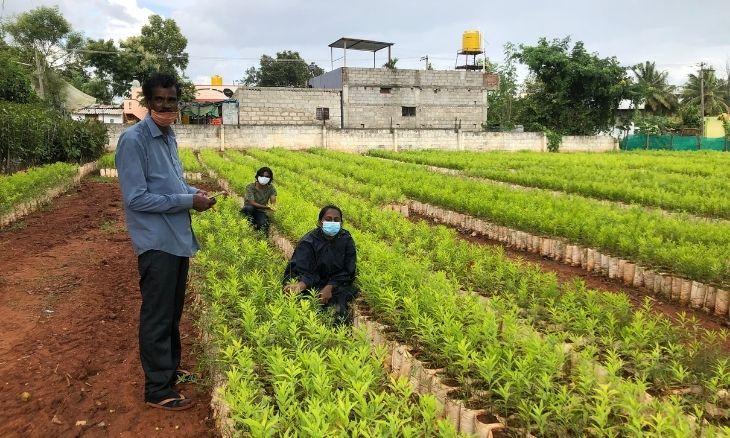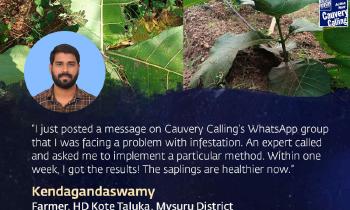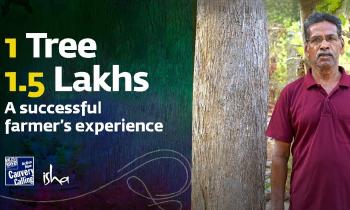Cauvery Calling: An Environmental Phenomenon
Enough of arm-chair activism masked as journalism!

In a recent piece in The Hindu, the writer bandies opinion based on some threadbare research of the Cauvery Calling Movement. We take great exception to this kind of irresponsible ‘journalism’, which would rather raise a canard out of two ounces of research and truckloads of speculation than see how they can make a real difference to some dire and urgent problems of our times. The kind of journalism that has no compunction in attempting to subvert people and organisations who are truly working towards a solution without even bothering to get acquainted with the basic facts of the matter.
We would like to set the record straight here.
About Cauvery Calling: The Cauvery Calling movement, which was launched in September 2019, is a 12-year project with an ambition to empower farmers to plant 242 crore trees on their own farmlands in the Cauvery River Basin Districts. The movement promotes tree-based agriculture that will incentivize farmers to plant high-value trees for economic gain and simultaneously restore green cover in the denuded Cauvery basin. Cauvery Calling aims to positively impact food and water security of 84 million people in Karnataka and Tamil Nadu. These 242 crore trees required to revive Cauvery can estimatedly sequester 200-300 million tonnes of CO2 by 2030. This is 8-12% of India’s 2030 Nationally Determined Contributions target. Isha’s efforts in the environmental sphere have resulted in Isha Foundation being accredited by United Nations Environment Programme (UNEP) and United Nations Convention to Combat Desertification (UNCCD). Additionally, Isha’s Project GreenHands initiative has been awarded India’s highest environmental award, the Indira Gandhi Paryavaran Puraskar, instituted by the Ministry of Environment and Forests, Government of India. Isha Outreach, the implementing agency of Cauvery Calling, is a member of the world’s foremost conservation body, the International Union for Conservation of Nature (IUCN).
Far from being merely a series of token plantations as alleged in the aforementioned article, Cauvery Calling has offered a model that is sustainable both ecologically and economically, and requires a deep involvement with farmers on the ground and policymakers at the top. It clearly demonstrates what it takes, on paper and on the ground, to bring about holistic and lasting transformation. It is aimed to be a demonstrable model for the rest of the nation and the tropical world.
To understand the level of involvement necessary for the implementation of such a project, please see:
- Cauvery Calling: First Year Update from the Ground (August, 2020)
https://www.youtube.com/watch?v=rpyQ0VHvCkk - Cauvery Calling: The Journey So Far (September, 2020)
https://www.youtube.com/watch?v=kB0STq_c_eE
Also, these two articles regarding the project’s progress:
- Cauvery Calling – The 1st Planting Season: An Update (August, 2020)
https://www.ishaoutreach.org/en/cauvery-calling/blog/cauvery-calling-1st-planting-season-update - Cauvery Calling: What it Takes on the Ground (September, 2020)
https://www.ishaoutreach.org/en/cauvery-calling/blog/cauvery-calling-what-it-takes-ground
Allegation 1: The Foundation is silent about the varieties of trees it aims to plant.
Since the inception of Rally for Rivers and the offspring Cauvery Calling, it has been clarified that we will be promoting native species that are both ecologically and economically beneficial. The exact list of species has been communicated openly to our primary stakeholders, the farmers, via social media, telephone calls, brochures, booklets, etc. during our outreach. Obviously, this piece of communication is crucial for any farmer who wishes to adopt tree-based agriculture. In all, across the basin states of both Tamil Nadu and Karnataka, we are promoting more than 80 species of trees.
Therefore, it is not a lack of clarity about the tree species on part of project teams, but laxity on the part of the writer, who chooses to dabble in superficial criticism without any effort towards familiarising herself with the work being done on the ground and its impact on the stakeholders.


Awareness material like this about various tree species has been widely made available to farmers who need this information to make suitable choices for their farmlands.
Allegation 2: The Foundation has remained silent about the funds the programme requires.
There is no ambiguity on this from Day One.
In 12 years time, the Cauvery Calling Project aims to plant 242 crore trees. Over the next decade, this requirement for sapling and other outlays could be fulfilled in several different ways. The vision of this movement is so large that it is ridiculous to suppose that it can be funded either in one shot or by any single entity. A movement of this magnitude will necessarily have to involve the support of multiple stakeholders over time: state governments, public individual donations of Rs 42 towards sapling and project costs, corporate sponsorship, international programs and other actors who may contribute in kind or through monetary support. As for the donations received for saplings, far from obscuring the matter, there is a prominent ticker showing this on the Cauvery Calling website landing page itself – which cannot be missed by anybody who has visited the page.
Allegation 3: The Foundation is silent on why a large-scale plantation drive is what the river and its dependent farmers need.
To understand why a project like Cauvery Calling is required, and what problems it addresses for the farmers and the river, the writer would not need to go even beyond the Cauvery Calling website landing page (www.cauverycalling.org) . This is also explained in the ‘Why Cauvery Calling?’ section of the website. The same has been communicated in dozens of articles and video interviews across various media houses, as has been again displayed clearly on the Cauvery Calling website here.
Cauvery Calling has never claimed that tree planting is the only solution for all the problems surrounding the Cauvery river. Isha has actively taken up one significant front of the problem and is working towards a long-term solution. Problems such as sand mining, pollution, encroachments etc are important too and we would greatly appreciate it if concerned people and organisations take up different aspects of the problem and start working on implementable solutions.
Allegation 4: Isha Foundation claims to benefit farmers, to ‘rejuvenate the soil, and improve farmers’ income’. But do we know for a fact that the land they aim to plant trees on are not farmlands in the first place?
Isha has experience with almost 70,000 farmers in Tamil Nadu who have implemented tree-based agriculture and have seen a rise of 3-8 times in their incomes. Tree-based agriculture is less labour intensive overall and has a high resistance to changing climate, floods and droughts. Trees are also an asset and insurance for farmers, which can be monetized in times of need instead of falling prey to creditors or debilitating financial stress.
Numerous farmer testimonies can be found on our Rally for Rivers and Isha Agro Movement channels. Listed here are a few from the basin states of Tamil Nadu and Karnataka:
Tamil Nadu
- Pepper Cultivation on Plains, yielding 400 kg in one acre fetching Rs 4 lakh: https://www.youtube.com/watch?v=C9em-KufcOk&list=PLNzLoCn3UYUuvEP0OAFJsKFi442jOf2Q-&index=3
- Coconut trees that withstand two years of drought: https://www.youtube.com/watch?v=msg2vIHA-o8&list=PLNzLoCn3UYUuvEP0OAFJsKFi442jOf2Q-&index=5
- Inspiring Story of Sentilkumar, who has been doing Natural Farming for the past ten years: https://www.youtube.com/watch?v=PkWPTV7DMPY&t=1220s
- Highly lucrative Red sanders cultivation – Rs 4 Crores on 1 acre: https://www.youtube.com/watch?v=zNIdSpdU38U&t=397s
- 1 Lakh trees grown by a doctor on 156 acres of land: https://www.youtube.com/watch?v=ggrc-rThWNo
- An old couple plants agro trees on 70 acres: https://www.youtube.com/watch?v=8Y6sHiA8TWc
- Melia Dubia fetches high income in a short span of time: https://www.youtube.com/watch?v=9y8MvMFfmp8
- Farmer finds increase in yield and income following Subash Palekar’s methods: https://www.youtube.com/watch?v=WLH26s6qcOg
- Planting teak and red sandalwood trees on 8 acres has been highly profitable: https://www.youtube.com/watch?v=EJcUR1KH9JE
Karnataka
- ಸಾಯಿರಾಮ್ತನ್ನ 4 ಎಕರೆಜಮೀನಿನಲ್ಲಿವರ್ಷಕ್ಕೆ 6 ಲಕ್ಷರೂಪಾಯಿಸಂಪಾದಿಸುತ್ತಾರೆ | ಮರಆಧಾರಿತಕೃಷಿ (Sai Ram earns 6 lakhs annually from his 4-acre farm | Tree-based Farming)
https://www.youtube.com/watch?v=NvfQlL6LB14 - ಮರಆಧಾರಿತಕೃಷಿನಿಶ್ಚಿತಅವಧಿಯಠೇವಣಿಇದ್ದಂತೆ | ರಮೇಶ್ರಂಗಸಮುದ್ರ (Tree-based farming is like a Fixed Deposit | Ramesh Rangasamudra)
https://www.youtube.com/watch?v=1-R_SATMdjk - ಇನ್ನು 20 ವರ್ಷಗಳಲ್ಲಿ, ಈಭೂಮಿ 2 ಕೋಟಿರೂಪಾಯಿಗಳಫಸಲುತರುತ್ತೆ! (In 20 years, this land will bring in Rs 2 crore of harvest! | Suresh)
https://www.youtube.com/watch?v=QLs4pt2a9yE - ನಾನುಮರಗಳನ್ನುನನ್ನಭವಿಷ್ಯಕ್ಕಾಗಿಬೆಳೆಸುತ್ತೇನೆ | 40 ಲಕ್ಷದಷ್ಟುಬೆಲೆಬಾಳುವಮರಗಳು 2.25 ಎಕರೆಯಲ್ಲಿ (I grow trees for my Future |Trees worth Rs 40 lakhs in just 2.25 acres)
https://www.youtube.com/watch?v=i-SaaX5cABg - ಸಸಿಹಾಕಬಾರದುಎಂದುಕೊಂಡಿದ್ದಶಿವೇಗೌಡರು, ಅದರಲ್ಲಿ 20+ ಲಕ್ಷದುಡಿದಿದ್ದುಹೇಗೆ? (How did Shive Gowda, who once thought he would not plant trees, earn over Rs 20 lakhs from tree-based farming?)
https://www.youtube.com/watch?v=hGeTz2vXw6s - ಎಕರೆಗೆ 10 ಕೋಟಿರೂಪಾಯಿ - ಇದುಶ್ರೀಗಂಧದಮ್ಯಾಜಿಕ್! (Rs 10 crore per acre - The Magic of Sandalwood)
https://www.youtube.com/watch?v=S8ZxZiU7x4M
More stories can be found here on Isha Agro Movement Youtube channel.
We are puzzled by the writer’s statement: “But do we know for a fact that the land they aim to plant trees on are not farmlands in the first place?”
As we have repeatedly made clear, the basic premise of Cauvery Calling is that the trees will be planted on farmers' own private lands. We are happy to report that thousands of farmers have begun the shift to tree-based agriculture in the last 6 months with 89 lakh saplings being already taken up this year; this number is expected to reach 1 crore by the end of the financial year.
Allegation 5: An article in Mongabay India (January 2020), says that ‘while Isha Foundation says it won’t plant monoculture plantations, the vagueness of the project has left it open for criticism... [it] can only be achieved through tampering with existing landscapes, including grassland ecosystems, experts say’.
Cauvery Calling is only focussed on enthusing farmers to plant trees on their own lands. No public or other lands, including forest lands or grasslands, are included under the scope of the program. Further, the choice of tree species and density lies ultimately with the landholder farmer. We will be generating awareness about various economically beneficial tree species appropriate for the soil and agro-climatic conditions and the benefits of polyculture plantations to support the farmer in making these decisions in a way that makes economic and ecological sense.
In fact, when tree-based agriculture co-exists with or complements conventional monoculture crops, it improves farm ecology and is accepted world-wide as a more efficient, holistic and sustainable system of agriculture. More than 20 different food crops can be grown in between trees as intercrops, which will provide extra income. Furthermore, intercropping is considered a superior carbon farming practice.
In conclusion, we would like to state our disappointment with a piece that is so badly researched that it cannot make a distinction between afforestation projects and a project based on tree-based agriculture. In this thinly veiled attempt to discredit the project, the author goes so far as to sweepingly say, “Simply planting trees does nothing”. By all means, let us not only plant trees. Let us, as Cauvery Calling has undertaken to do, educate our farmers on ecologically sustainable land and water use. Let us understand the various bottlenecks and strive to change policy in that direction. Let us bring multiple stakeholders from UN bodies and governments and farmer groups together to work on solutions. Let us raise Human Consciousness so that every human being who is currently the source of the problem (whether pollution or sand mining) can start to realise that he needs to be a part of the solution. Let us do all these things. At Isha we are working day and night, 7 days of the week, 365 days of the year without a break to make this happen.
Anyone who is concerned about the state of the planet, we assume, would be supportive of all efforts in this direction – after all, it is a battle that must be fought on several fronts. It leaves us to wonder about people who ostensibly share this concern but are yet so resistant that they would seek to discredit an earnest undertaking like Cauvery Calling. What could be the motivations of such people? Among efforts to bog down the project was a recent PIL against the Movement, in which the litigant exposed himself, his mal-intent and loaded agenda in the full light of court, drawing the ire of the court to the extent of being removed from the proceedings. Evidently, neither a sense of propriety nor real concern for the environment is able to weigh with certain sections when compared to their own vested interests. There can be no other explanation as to why people would try to damage a well-meaning and well thought out endeavour such as Cauvery Calling.











An ancient Sithar Tamil song line roughly translates to 'a fruit-bearing tree alone (& not a worthless tree) with get hit by stones often'. Keep going Cauvery Calling....!!!